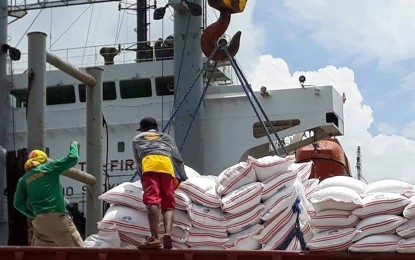
File photo
MANILA – President Rodrigo Duterte has decided to lower the tariff rates on imported rice to address the 10-percent supply shortfall, Malacañang said on Thursday.
This, after several senators raised concern over Duterte’s decision to impose a temporary reduction of rice tariffs.
“Ang iniiwasan lang po natin, bagama’t meron po tayong napakataas na ani ng bigas ngayon, meron pa rin po tayong shortfall na mga 10 percent (Although we have ample harvest of rice, what we are avoiding is a shortfall which is about 10 percent),” Presidential Spokesperson Harry Roque said in an online press briefing.
On May 15, Duterte signed Executive Order (EO) 135 which lowers the Most Favored Nation (MFN) tariff rates on rice to 35 percent from 40 percent for in-quota purchases and 50 percent for out-quota purchases for a period of one year.
Duterte adjusted MFN tariff rates on imported rice to “diversify the country’s market sources, augment rice supply, maintain prices affordable, and reduce pressures on inflation.”
Senate Minority Leader Franklin Drilon and Senators Francis Pangilinan, Nancy Binay, Leila de Lima, and Risa Hontiveros on Wednesday filed Senate Resolution 726, urging Duterte to withdraw EO 135.
The senators claimed there is “no reasonable and sufficient” basis to reduce the tariff rates on imported rice.
They added that Duterte’s latest directive would only “cause more burden to our local rice farmers, further increase our import dependency, and cost the government millions in foregone revenues.”
Roque said the tariff cut on imported rice would also help temper the country’s inflation.
“Kung tataas na naman po ang presyo ng bigas eh makakaapekto na naman iyan, magreresulta sa mas mataas na inflation (If the price of rice goes up, it will have an impact on the country’s inflation. It will result in higher inflation),” he said.
He added that the tariff cuts on imported rice are lower compared to the cuts on imported pork products.
“Ang iniiwasan nating nga is ‘yung maapektuhan ang ating rice security kaya binaba natin ng bahagya (We want to ensure rice security so we slightly cut the tariff rates),” he said. “Iyan hindi gaya nang nangyari sa baboy na more than kalahati. Halos binura na ang taripa (It is different from what happened to the tariff rates on imported pork that was reduced by more than half. The tariff was almost removed).”
Roque was referring to the temporary tariff reduction on fresh, chilled, or frozen pork products.
Duterte initially issued EO 128 which reduces the tariff rates on pork imports within the minimum access volume (MAV) to 5 percent for the first three months upon the effectivity of the order and 10 percent for the next nine months from the current rate of 30 percent.
Pork imports outside MAV, according to EO 128, were reduced with a lower tariff of 15 percent for the first three months and 20 percent for the succeeding nine months from the current rate of 40 percent.
On May 15, Duterte signed EO 134 which supersedes EO 128 and raises pork imports within MAV to 10 percent for the first three months and 15 percent for the next nine months.
Pork imports outside MAV increase to 20 percent for the first three months and 25 percent for the succeeding nine months. (PNA)
